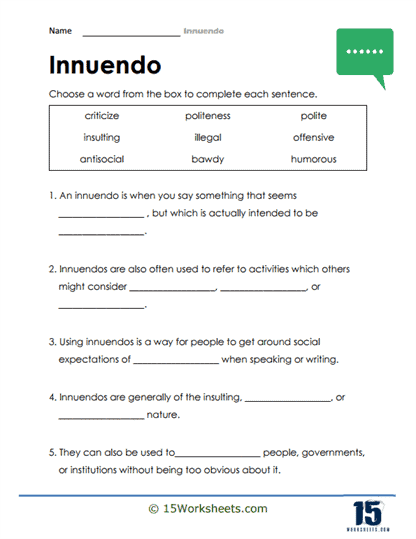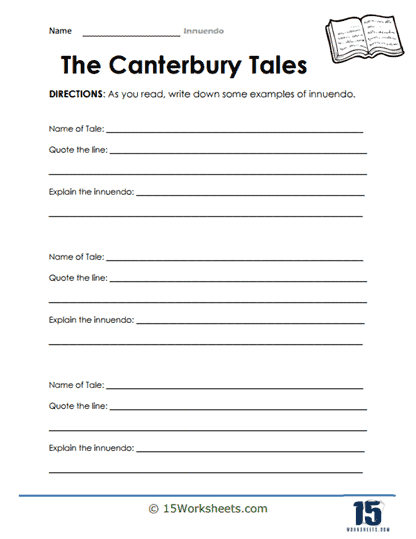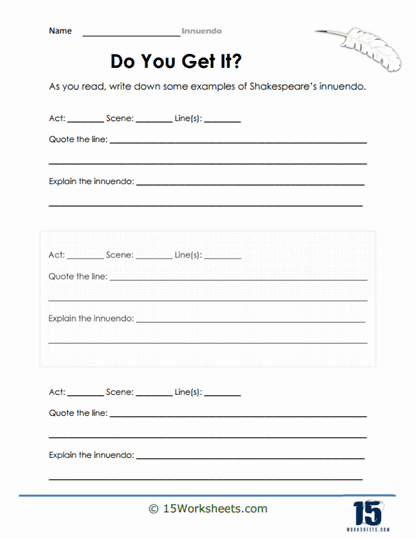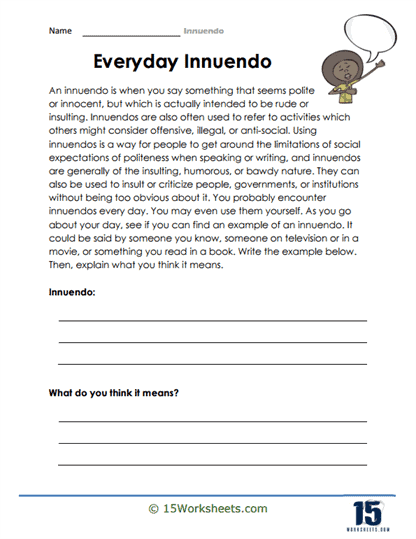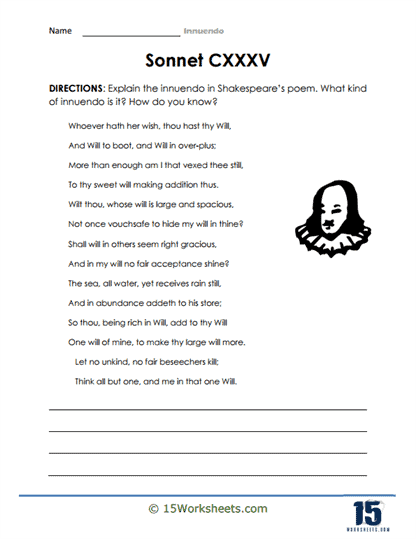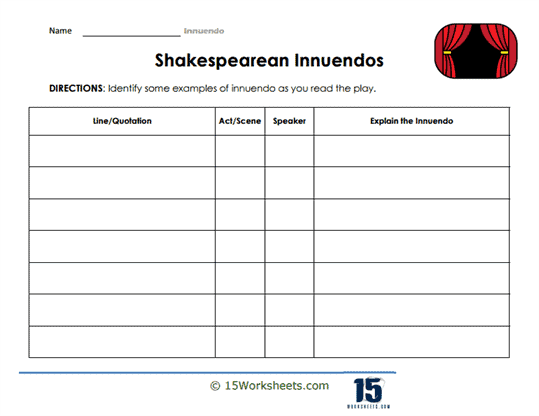Innuendo Worksheets
About These 15 Worksheets
Innuendo worksheets are educational resources designed to help students understand and analyze the use of innuendo in language arts. Innuendo, a figure of speech where the speaker suggests something indirectly or hints at something without stating it explicitly, is often used to imply something controversial, inappropriate, or humorous without direct mention. These worksheets aim to develop students’ critical thinking, interpretive skills, and sensitivity to nuanced language, enhancing their ability to engage with complex texts and communicate effectively.
Through a variety of exercises, these worksheets equip students with the ability to recognize and analyze the nuanced use of language, appreciate the complexity of communication, and engage ethically and effectively in their personal and academic lives.
Types of Exercises
Identification Exercises – Students are given texts containing examples of innuendo and are asked to identify the implied meanings or suggestions. This basic exercise helps students recognize innuendo in various contexts, from literary works to everyday conversations.
Analysis – Beyond identification, students analyze the purpose and effect of the innuendo within a text. They might explore why the author chose to imply rather than state something directly and how this affects the reader’s interpretation or the tone of the piece. This type of exercise encourages deep critical thinking about authorial intent and reader response.
Comparisons – These exercises involve comparing texts with and without innuendo to evaluate how innuendo changes the tone, mood, or implications of a message. Students consider how the subtlety of innuendo can alter understanding or add layers of meaning to a text, enhancing their appreciation for nuanced communication.
Create Your Own – Students try their hand at writing their own examples of innuendo, based on given scenarios or themes. This encourages creativity and allows students to practice using innuendo effectively in their writing, understanding its power to suggest rather than tell.
Contextual Understanding – These exercises help students explore how innuendo’s meaning can change depending on the context, including cultural, social, and historical factors. Students might analyze the use of innuendo across different cultures or time periods, enhancing their cultural literacy and historical understanding.
Interpretation and Debate – Students are presented with ambiguous texts where the innuendo can be interpreted in multiple ways. They must argue for their interpretation based on textual evidence, promoting debate and discussion that enhances interpretive skills and persuasive argumentation.
Sensitivity Training – Recognizing that innuendo can sometimes be used inappropriately or harmfully, these exercises help students understand the ethical considerations of using innuendo, promoting empathy and responsible communication.
Media Literacy Exercises – Given the prevalence of innuendo in advertising, social media, and film, these exercises encourage students to identify and analyze innuendo in various media forms, enhancing their media literacy and critical viewing skills.
The Benefits of These Worksheets
Engaging with innuendo worksheets offers a multifaceted approach to improving students’ language arts and reading skills:
Enhanced Interpretive Skills – By learning to identify and understand innuendo, students develop a keen eye for subtlety in language, enhancing their ability to interpret complex texts and read between the lines.
Critical Thinking Development – Analyzing the use and effects of innuendo encourages students to think critically about language and its power to influence, persuade, and entertain, fostering a deeper understanding of rhetorical strategies.
Creative Writing Enhancement – Creation exercises stimulate students’ creativity, encouraging them to use innuendo in their writing to suggest rather than state outright, which can add depth and nuance to their narratives and arguments.
Cultural and Historical Awareness – Exploring the use of innuendo across different contexts broadens students’ cultural and historical perspectives, helping them appreciate the diversity of communication styles and the evolution of language over time.
Improved Persuasive Skills – Understanding how innuendo can subtly influence thought and behavior enhances students’ persuasive writing and speaking skills, equipping them with sophisticated rhetorical tools.
Empathy and Ethical Communication – Sensitivity training exercises promote empathy by making students aware of the potential impact of innuendo, guiding them towards more ethical and responsible use of language.
Media Literacy – Given the prevalence of innuendo in various media, analyzing its use in advertising, social media, and film enhances students’ ability to critically engage with media, making them more discerning consumers and creators of content.
Debate and Discussion Skills – Interpretation and debate exercises encourage students to articulate their views, support their arguments with evidence, and engage in constructive dialogue, honing their verbal communication and critical listening skills.
What is the Literary Device of Innuendo?
Innuendo, as a literary device, serves as a subtle or indirect observation about a subject, often used to imply something derogatory, to introduce humor, or to convey hidden messages that are not explicitly stated. The use of innuendo allows authors to navigate sensitive topics, critique societal norms, or develop character dynamics in a nuanced manner, without direct exposition. The main defining feature of innuendo is its reliance on implication and suggestion, rather than explicit statement, requiring the audience to infer the underlying meaning or intention behind the words.
Characteristics of Innuendo
Subtlety and Indirectness – Innuendo operates through subtle hints or indirect references, leaving much to the reader’s interpretation. This characteristic demands engagement and a level of sophistication from the audience, as the true message is veiled.
Reliance on Context and Connotation – The meaning of an innuendo often depends on the context in which it is used, as well as the connotations of the words or phrases employed. Audience understanding can vary based on cultural, social, or personal knowledge.
Ambiguity – Innuendo frequently involves a degree of ambiguity, allowing for multiple interpretations. This ambiguity can protect the speaker or author from outright stating something potentially offensive, controversial, or inappropriate.
Humor and Irony – Often, innuendos are employed for humorous effect, exploiting the double meanings of words or phrases for comedic purposes. They can also be used ironically, underscoring the contrast between the said and the unsaid.
Critique and Satire – Innuendo can serve as a tool for critique or satire, allowing authors to comment on social, political, or moral issues indirectly. This can make the critique more palatable or accessible to the audience.
Examples of Innuendo in Literature
Example 1 – William Shakespeare’s “Hamlet”
Shakespeare frequently used innuendo for both humor and plot development. In “Hamlet,” the titular character’s exchange with Ophelia during the play-within-a-play scene is rife with sexual innuendos. Hamlet’s comments, such as asking Ophelia if he may lie in her lap and the subsequent banter, are loaded with double meanings that suggest sexual activity. This use of innuendo serves several purposes – it highlights Hamlet’s complex relationship with Ophelia, showcases his descent into madness (or feigned madness), and adds a layer of dark humor to the play. For the audience, deciphering these innuendos adds depth to their understanding of Hamlet’s character and his interactions with others.
Example 2 – Jane Austen’s “Pride and Prejudice”
Austen skillfully uses innuendo to critique societal norms and character flaws. The dialogue between characters often contains subtle digs and implications about their social standing, intentions, or morality. For example, Mr. Darcy’s initial description of Elizabeth Bennet as “tolerable, but not handsome enough to tempt me” can be seen as an innuendo regarding societal expectations of marriage and attraction. Austen’s use of innuendo allows her to comment on the superficiality and snobbery of the upper class while maintaining the decorous language and manners expected of her characters. Readers are invited to read between the lines to grasp the full extent of Austen’s social commentary.
Example 3 – Oscar Wilde’s “The Importance of Being Earnest”
Wilde’s play is renowned for its witty dialogue and clever use of innuendo, particularly in highlighting the absurdities of Victorian society and the duplicity of its characters. The character Algernon’s statement, “I really don’t see anything romantic in proposing. It is very romantic to be in love. But there is nothing romantic about a definite proposal,” serves as an innuendo regarding the nature of love and marriage in Victorian society. Wilde’s innuendos critique the transactional nature of marriage and the performative aspects of romance, engaging the audience in a deeper reflection on the societal norms of his time.
The Effect of Innuendo on the Reader
The use of innuendo in literature has a profound impact on the reader, engaging them in a more active reading experience. Innuendo:
Engages the Reader’s Intellect and Imagination – Deciphering innuendo requires readers to engage their intellect and imagination, making the reading experience more interactive and rewarding.
Creates Humor and Irony – Innuendo can add layers of humor and irony to a narrative, enriching the reader’s emotional experience and deepening their appreciation of the text.
Enhances Characterization and Plot Development – Through innuendo, authors can subtly develop characters and advance the plot without overt exposition, adding complexity and depth to the narrative.
Invites Multiple Interpretations – The ambiguity of innuendo encourages multiple interpretations, fostering lively discussion and debate among readers and critics.
Facilitates Subtle Critique – Innuendo allows authors to critique societal norms, behaviors, and institutions indirectly, making their criticisms more accessible and palatable to the reader.






